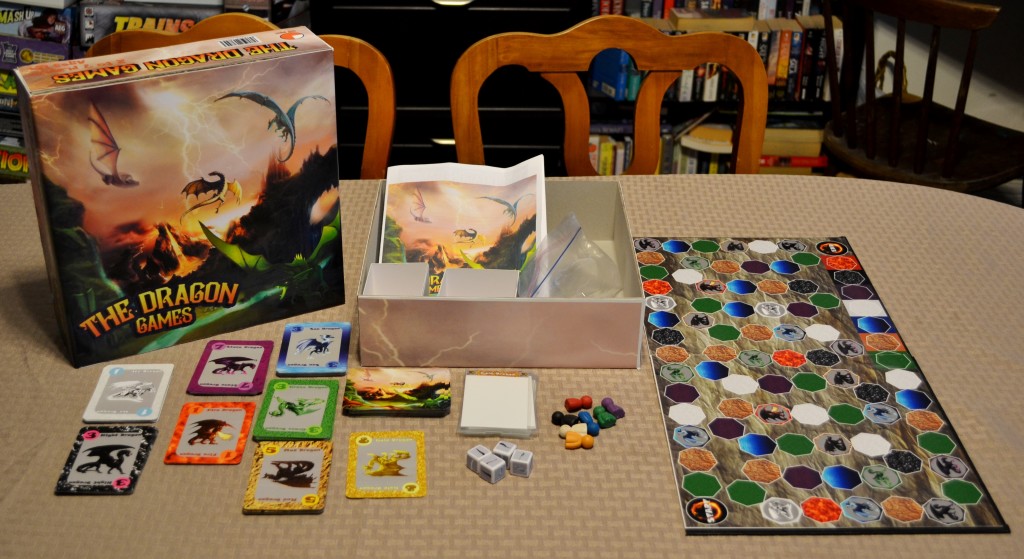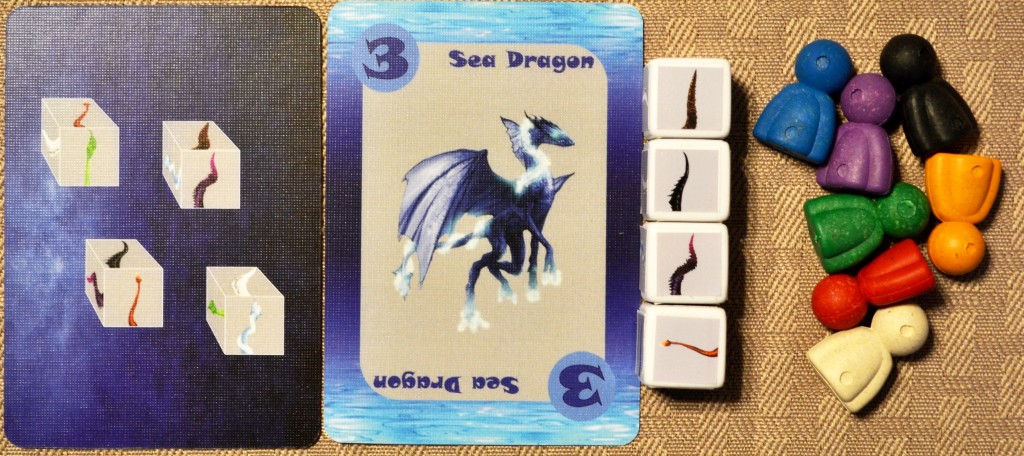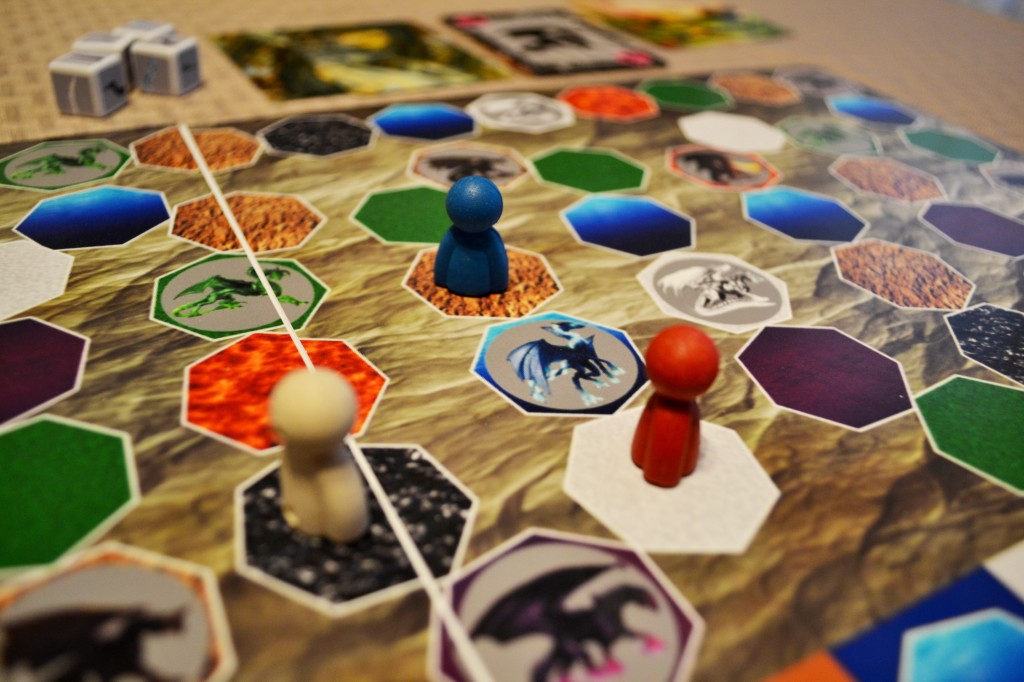There are a TON of trick-taking games out there…but seriously, how many of them feature dragons? “THE DRAGON GAMES”, a family-friendly trick-taking card game that will be launching on Kickstarter on or around 6/28/14, has them in “Spades” (pardon the reference). In this variant, players will assume the role of an actual playing piece, unlike most card games of the genre. By winning tricks, you’ll be able to advance your pawn further up the playing board. The first player to reach the end of the path, wins! Before we take a brief look at what this game has to offer, I’d like to thank Carl Hansen and Rebecca Smith from Dream Options Inc. for reaching out and providing me with a prototype copy. It’s important to stress that prototypes are not often reflective of the final product, making everything featured in this article (including the rules) subject to change. The symbols on the dice, for example, will be a bit more clear in the final version.
Firstly, let’s touch on the components. My prototype copy came with one playing board, one hundred and thirty-five playing cards, thirty-five dragon cards, four dice, a card organizer, and seven game markers. Of the one hundred and thirty-five cards, one hundred and thirty-three are broken up across seven suits numbered “1” thru “7”. Some suits have duplicates of the same suit/number while others do not. The remaining two of the one hundred and thirty-five cards are jokers, colored gold, and considered “trump” cards. The thirty-five dragon cards are, for lack of better term, “action” cards that allow players to take the listed special action any time they wish. The dice contain symbols for the seven suits in the game, the purpose of which I’ll explain later. The board consists of multi-colored spaces matching the suit colors in the playing card deck. The game markers simply serve to mark a particular player’s location on the board at any given time.
If you’re like me, then you probably haven’t played many trick-taking card games. Heck, I break out into a sweat and get intimidated every time I hear the word, “Pinochle”. Before we get started with the gameplay, it’s worth defining some important key words that you’ll hear from time to time. A “trick” is a series of card plays led by a player, with others laying down cards down in turn. At the end of the trick, a winner is evaluated depending on the circumstances (rules) and they collect the trick or the pile of cards that have accumulated. Most tricks in this genre require players to follow a particular order or rule, like playing cards of the same suit led by the first player (and what have you). “Trump” cards are the exception in that they always have a greater value than the initial card that led the trick. Again, the rules of “tricks” and “trumps” vary depending on what trick-taking card game you’re playing.
With this in the back of your mind, “THE DRAGON GAMES” is broken up into a series of turns, with each player leading a trick on their turn. Before anything happens though, players will need to first set up the decks. The seven colored suits/cards are broken up into their own individual piles and shuffled separately. For the sake of simplicity, let’s call this set of seven cards “Group A”. From there, players will take a set number of cards from each deck and combine them, along with the two gold dragon (joker) cards, into one giant mixed playing deck. Let’s call this mixed deck “Group B”. I felt the labeling to be important, since you’ll be drawing from both sources (groups) throughout the game.
Each player will observe a series of steps/phases on their turn. To sum up the process, the active player will deal seven cards to all players from “Group B”, or the mixed deck. The active player will then roll the dice, look at their position on the board, and choose a colored suit as trump (or the active/important suit for that turn). The active player will then draw extra cards of their chosen color from “Group A”, depending on what color was picked and how many dice of that color were rolled (one card per one matching colored die result). The rules vary slightly here, depending on how many people are playing. In a two player game for example, the other player will also roll the dice and collect cards from “Group A” depending on the dice results and the color selected by the active player. Partners are also possible in five to seven player games.
From here, the hand is played out. Each player will choose one card in turn (led by the active player) and the highest value of the trump color/suit shown wins the trick. Golden dragons (jokers), when played, automatically win the trick. Winning a trick simply involves placing all of the cards (one from each player) into a pile in front of you. The player that won the trick will then choose another card and the process repeats until everyone’s hand is empty. The active player will then look to see if they’ve won enough tricks to satisfy the requirement, which changes depending on how many people are playing. Five tricks are required in a two player game, for example, while only three are needed in a seven player game.
If successful, they’ll get to move their character/pawn to the next space on the board of that trump color, plus one trump space for every trick won after the requirement. If unsuccessful, the active player’s opponents will instead move a number of trump spaces equal to the difference of the trick requirement minus the tricks won by the active player. Anyone who lands on a dragon space gets to draw a dragon card (again, these are action cards of sorts that can be played at any time). Once the appropriate players have moved, the cards from that hand (now in trick piles) are placed in the mixed deck (“Group B”), which is then reshuffled. The mixed deck (“Group B”) will get larger as the game progresses, changing the odds a bit in the process. Players will take turns being the active player until someone has landed on the “End” space. Whoever does, wins!
So, what did I think? Our play tests were positive overall. I did have to explain the idea of “tricks” and “trumps” a few times, though this isn’t the game’s fault. We rarely play quote unquote “regular” card games in the house, let alone trick-taking games, so some of the terms were a bit foreign to us. Once we got a few turns under our belt, I began to see the benefit of keeping two, separate piles (“Group A” and “Group B”). As more of the same color is chosen as trump, the more it’ll potentially appear in “Group B” when players draw their seven card hand at the beginning of their turn. This ever-changing odds mechanic, coupled with the fact that some colors/suits have fewer cards, will really make players think about what color they’d pick as trump on their turn. There’s also the fact that you’ll want to maximize your movement should you win the trick requirement on your turn and again, this is based on your character’s position in relation to the colors around him/her.
While trick-taking games have been around for centuries, “THE DRAGON GAMES” keeps things fresh by daring to be different. “Spades” and “Clubs”, for example, don’t feature a board with characters moving along multicolored spaces. It’s almost as if “Candy Land”, “Clubs”, and “Lords of Vegas” had secretly been conversing in someone’s back closet, trying to come with a new game with which to entertain themselves while waiting to be played by their master. It’s a pretty ingenious idea that would appeal to kids and adults alike. If you and your family are regular card sharks and are looking to take your game to the next level, then “THE DRAGON GAMES” just might be what you need to spice things up.
—
You can learn more about and support, “THE DRAGON GAMES” by visiting its Kickstarter page, here:
https://www.kickstarter.com/projects/1285589445/the-dragon-games-where-the-strategy-is-ever-changi
—



